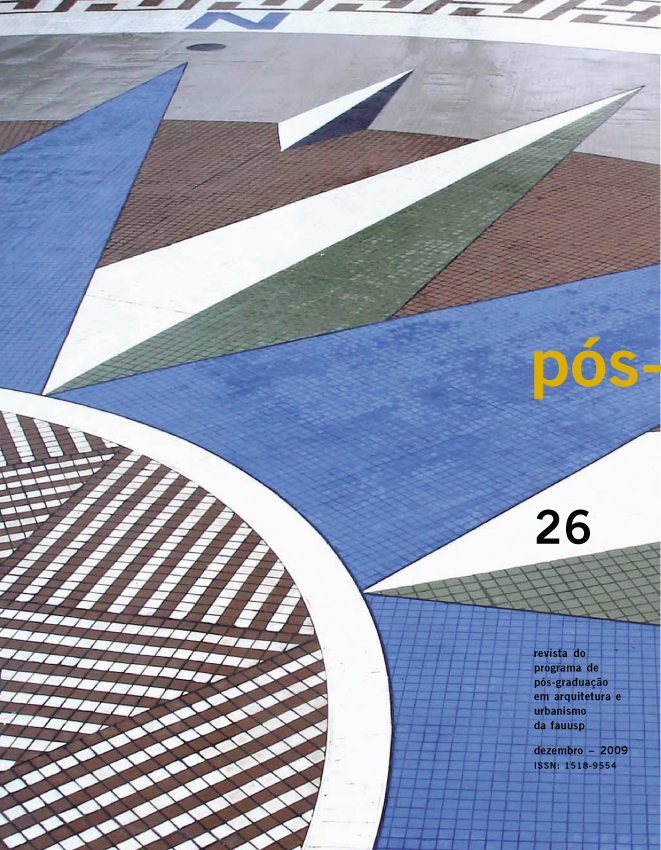Sevilla y el doble guadalquivir: breve análisis del reciente fenómeno de integración ciudad-río
DOI:
https://doi.org/10.11606/issn.2317-2762.v0i26p92-108Palabras clave:
Sevilla, paisaje, ríos urbanos, percepción ambiental, semióticaResumen
Tras un complejo conjunto de obras hidráulicas realizado durante el siglo 20, el río Guadalquivir, principal curso de agua de Andalucía (España) sufre una serie de intervenciones físicas que altera radicalmente su diseño desde la desembocadura hasta Sevilla. Dentro de los límites de esta ciudad, la reconfiguración - iniciada por la corta de Tablada (años 1920) y seguida por las cortas de Triana (años 1950) y de la Cartuja (1970), con el objetivo de mejorar las actividades portuarias y evitar constantes inundaciones - provoca una curiosa duplicación del río, que se divide en un tramo" histórico" (estancado y transformado ahora en dársena) y un tramo" vivo" (por donde sigue hasta el mar). Al mismo tiempo, la capital andaluza se expande hacia sur (incentivada por la Exposición Iberoamericana de 1929), este y norte, convirtiéndose en la sede de la nueva región metropolitana. Con las inversiones para la Exposición Internacional de 1992 (Expo'92), son finalmente ocupados los terrenos de la Cartuja, a oeste del casco histórico, y la reconfiguración de los sistemas de ferrocarriles y rondas devuelve a la ciudad un gran tramo del río antes aislado (avenida Torneo). Mientras el puerto es trasladado hacia Tablada, al sur, el viejo muelle del Arenal recibe el primer proyecto de reintegración del río a la ciudad. Nuevos paseos y puentes conectando el antiguo núcleo urbano a Cartuja complementan este nuevo paisaje, apoyado aún por los actuales planes urbanísticos. A través de una descripción histórica de este proceso y de una breve análisis visual del doble Guadalquivir, buscamos identificar valores reflejados en la actual conformación urbana del río, deteniéndonos sobre todo a la apertura realizada (y que sigue ocurriendo) en su" histórico" curso.Descargas
Referencias
ARGAN, Giulio Carlo. História da arte como história da cidade. São Paulo: Martins Fontes, 1993.
COSTA, Lucia Maria Sá Antunes Costa. Rios urbanos e o desenho da paisagem. Rios e paisagens urbanas. Rio de Janeiro: Viana & Mosley/Prourb, 2006.
FERRARA, Lucrécia d’Alessio. Ver a cidade: Cidade, imagem, leitura. São Paulo: Perspectiva/Studio Nobel, 1988.
GUCCIONE, Biaggio; MELI, Andrea; RISICARIS, Giorgio (Org.). A networking experience for successful city-river interfaces. Firenze: Edifir, 2006.
GUTIERREZ, Victoriano Sainz. El proyecto urbano en España (Génesis y desarrollo de un urbanismo de los arquitectos). Sevilha: Universidad de Sevilha, Consejería de Obras Públicas y Transportes de la Junta de Andalucía, 2006.
ITUARTE, Leandro de Moral. El agua en la organización del espacio urbano: el caso de Sevilla y el Guadalquivir. Documento Análisis Geográfica. Sevilha, n. 31, p. 117-127, 1997.
ITUARTE, Leandro de Moral. El puerto y la ría del Guadalquivir: mitos, rupturas y continuidades. In: VALVERDE, Antonio Piñero et al (Org.). Puerto Y ciudad. II Foro de Arquitectura y Urbanismo de la Universidad de Sevilla. Sevilha: Escuela Técnica Superior de Arquitectura, 2004.
LOPEZ, Manuel A. Martín. Un factor clave en el horizonte económico de Sevilla: el puerto. In: VALVERDE, Antonio Piñero et al (Org.). Puerto Y ciudad. II Foro de Arquitectura y Urbanismo de la Universidad de Sevilla. Sevilha: Escuela Técnica Superior de Arquitectura, 2004.
MERLEAU-PONTY, Maurice. O primado da percepção e suas consequências filosóficas. Campinas: Papirus, 1990.
POZUETA, Julio. Transformación de espacios portuarios en áreas urbanas (experiencia española y marco internacional). Revista Urbanismo, Madri, n. 27, 1996.
SASTRE, Francisco Javier Pando (Org.). Historical river centres: Sevilla y el río Guadalquivir. Sevilha: Programa Cultura, 2000.
VALVERDE, Antonio Piñero; GUTIERREZ, Victoriano Sainz. Planeamiento y espacio portuario en la Sevilla contemporánea. In: VALVERDE, Antonio Piñero et al (Org.). Puerto Y ciudad. II Foro de Arquitectura y Urbanismo de la Universidad de Sevilla. Sevilha: Escuela Técnica Superior de Arquitectura, 2004.
Descargas
Publicado
Número
Sección
Licencia
La revista Pós. del programa de postgrado FAUUSP está licenciada con una licencia Creative Commons Attribution 4.0 International License.
El titular de los derechos de autor es el autor del artículo. La revista Pós. sólo exige que la publicación del artículo sea inédita. El autor tiene el derecho de divulgar su artículo según su conveniencia debiendo citar la revista.
La revista Pós. autoriza la republicación de sus artículos desde que debidamente citada fuente y autoría.
DIADORIM - Diretório de Políticas Editoriais













